|
Salvia (Salvia farinacea, and Salvia leucantha)
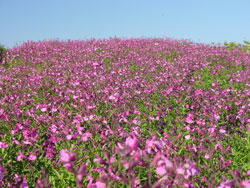
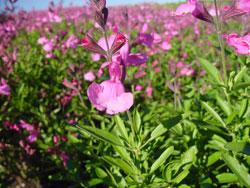
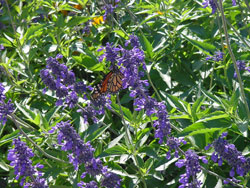
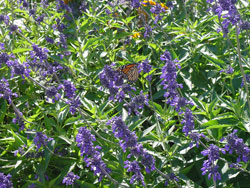
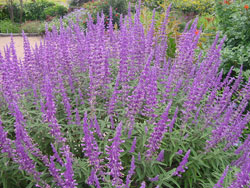
--OCT_small.jpg)
--OCT_small.jpg)
Salvia is a large family of plants that is very important to the xeriscape landscape.
Place tall salvias in front of evergreen shrubs; mass them for incredible impact; spot them around in an herb garden to complement the mostly green garden. The taller Texas salvias (2 to 6 feet) are the best for cut flowers, so you may want to put a separate bed of them in a cutting garden. One of the most delightful aspects of salvias is that they attract butterflies and hummingbirds. Combine red with yellow coreopsis, Laura Bush petunias, and yellow or pink cosmos for the start of a butterfly and hummingbird garden. Whatever design you decide on, remember to plant in masses of at least eight or more plants of each color and type. Hummingbirds and butterflies will flock to this garden favorite.
Set salvias in the ground at the same depth or slightly below the level they were growing in the pots. Salvia needs only basic care to provide a colorful abundance of blooms all summer long. After the seedlings emerge, water VERY SPARINGLY. In lieu of any rainfall during an entire month, give the planting bed a long, slow drink. Salvia is drought tolerant, providing abundant blooms with less water than most other plants. Herein lies the problem which many people encounter when growing salvia -- they over-care for their salvia plants. Over-care means too much water and too much fertility. Texas tough perennial salvia are not heavy feeders. Excess fertilization will cause plants to grow too tall and produce excessive leaf growth at the expense of flower production. When ?ver-care occurs, salvia becomes tall and spindly and blooms sparsely. When the spring-planted or spring-sprouting salvia begins to look as if there are an abundance of dried seed pods, encourage new growth and re-bloom simply by cutting the plants back to one-half their height. They will be back in bloom in less than a month.
In addition to looking beautiful in the garden, salvias make great cut flowers. They add touches of color to country-style arrangements, spiky height to miniature bouquets, and accents to wreaths and swags. Salvia are particularly pretty as cut flowers, whether fresh or dried. Fresh-cut salvia bring an airy appearance to arrangements. To gather salvias for fresh or dried arrangements, cut them when about half of the flowers have begun to open on each stem - the flowers open from the bottom up. Most gardeners find Salvia to be relatively pest - and disease - free. And the GOOD NEWS IS, it is not a preferred food for the deer population.
See: http://plantanswers.com/salvia.htm and http://plantanswers.com/salvia_arcadia.htm
And http://aggie-horticulture.tamu.edu/southerngarden/cutflower.html and
http://plantanswers.com/arcadia_pages/plant_of_the_month/salvia_leucantha.htm
|



